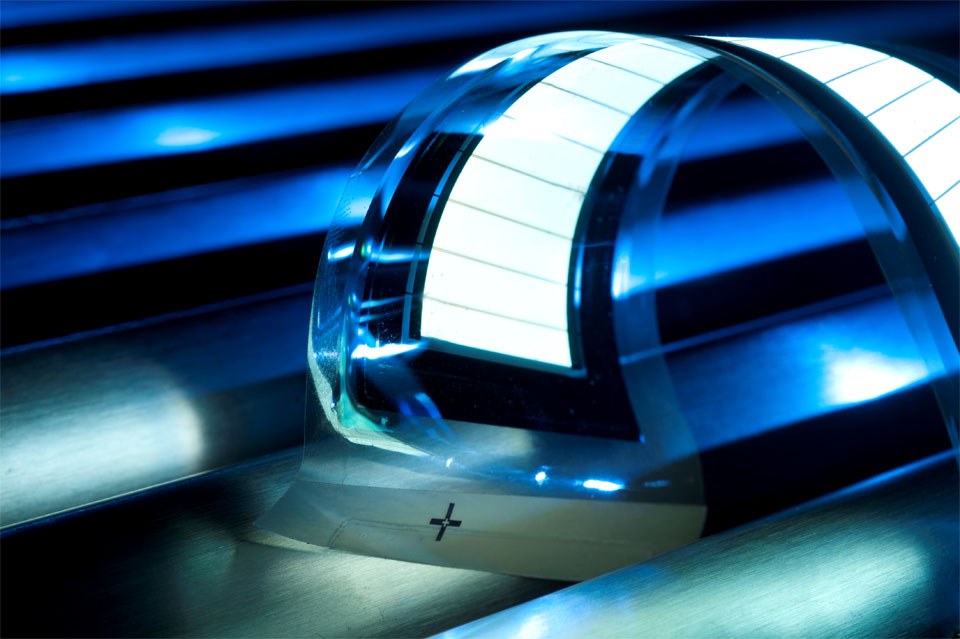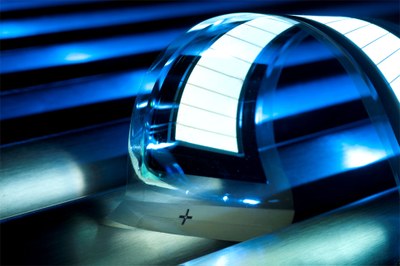EU Project IMOLA Starts R&D on Large-Area, Intelligent OLED Lighting
Imec and its project partners announce the launch of IMOLA (Intelligent light Management for OLED on foil Applications), a project under the EU’s 7th framework program for ICT (FP7). The project’s goal is to make large-area OLED-based lighting modules with built-in intelligent light management. These systems will be used in future energy-efficient wall, ceiling and car dome lighting, where the light intensity can be adjusted intelligently, e.g. according to the time of the day or weather conditions.
OLEDs (Organic Light-Emitting Diode) are paper-thin, flexible and lightweight electronic devices. They consist of organic materials which emit light in response to an electric current. OLEDs consume up to 70% less energy compared to conventional light sources. This makes OLED technology a prime candidate for the next generation of energy-saving lighting. But before flexible large-area OLED lighting can be commercialized, more R&D is needed to solve some outstanding challenges. These areas, which mainly concern the driving electronics, power distribution, integration and miniaturization, as well as sensors and application intelligence, will be tackled by IMOLA.
The IMOLA consortium includes industrial and academic partners that are leaders in their field of expertise. Next to imec, the project coordinator, the partners involved in IMOLA are TNO/Holst Centre (Netherlands), Philips Technologie (Germany), NXP Semiconductors (Netherlands, Belgium), Hanita Coatings RCA (Israel), Henkel Electronic Materials (Belgium), Centro Ricerche Plast-optica (Italy), and the FER department of the University of Zagreb (Croatia).
IMOLA’s application demonstrators in the areas of car and wall lighting will raise public awareness and acceptance for environmental-friendly OLED lighting. In addition, IMOLA will help create a common OLED infrastructure on a European scale. IMOLA’s R&D results will help to give Europe a leading edge in OLED fabrication, especially in the field of high value-added applications, such as automotive lighting.
PROJECT PARTNERS:
About imec:
Imec performs world-leading research in nanoelectronics. Imec leverages its scientific knowledge with the innovative power of its global partnerships in ICT, healthcare and energy. Imec delivers industry-relevant technology solutions. In a unique high-tech environment, its international top talent is committed to providing the building blocks for a better life in a sustainable society. Imec is headquartered in Leuven, Belgium, and has offices in Belgium, the Netherlands, Taiwan, US, China, India and Japan. Its staff of about 1,900 people includes more than 500 industrial residents and guest researchers. In 2010, imec's revenue (P&L) was 285 million euro. Further information on imec can be found at www.imec.be.
Imec is a registered trademark for the activities of IMEC International (a legal entity set up under Belgian law as a "stichting van openbaar nut”), imec Belgium (IMEC vzw supported by the Flemish Government), imec the Netherlands (Stichting IMEC Nederland, part of Holst Centre which is supported by the Dutch Government), imec Taiwan (IMEC Taiwan Co.) and imec China (IMEC Microelectronics (Shanghai) Co. Ltd.) and imec India (Imec India Private Limited).
About TNO/Holst Centre:
With more than 4000 professionals, TNO is the largest Dutch organization for applied research. The activities of TNO within IMOLA are being conducted by its research division at Holst Centre. Holst Centre is an independent open-innovation R&D centre, set up in 2005 by imec (Flanders, Belgium) and TNO (The Netherlands). Holst Centre develops generic technologies for Wireless Autonomous Sensor Technologies and for Flexible Electronics. A key feature of Holst Centre is its partnership model with industry and academia around shared roadmaps and programs. It is this kind of cross-fertilization that enables Holst Centre to tune its scientific strategy to industrial needs. Holst Centre was setup with support from the Dutch Ministry of Economic Affairs and the Government of Flanders. It is named after Gilles Holst, a Dutch pioneer in Research and Development and first director of Philips Research. Located on High Tech Campus Eindhoven, Holst Centre benefits from the state-of-the-art on-site facilities. Holst Centre has over 170 employees from 28 nationalities and a commitment from over 30 industrial partners. More information: www.holstcentre.com
About Philips Technologie GmbH:
The core business of Philips Technologie GmbH is lighting: automotive, lamps, lighting electronics, SSL, luminaires, lumileds, special lighting. Philips is No.1 in the global lighting market, a position supported by leadership in innovation combined with a systematic approach to seeking out new market opportunities. Philips Lighting strives to improve people’s life with effective and appealing lighting solutions based on a thorough understanding of people’s needs, desires and aspirations. It wants to be recognised by all its stakeholders as setting the pace in the lighting industry, as the best partner to do business with, as the best company to work for and as a responsible corporate citizen contributing to the sustainability of society at large.
The division’s products are found all around the world: not only everywhere in the home, but also in a multitude of professional applications, for example, 30 per cent of offices, 65 per cent of the world’s top airports, 30 per cent of hospitals, 35 per cent of cars and 55 per cent of major football stadiums. The main products include a full range of incandescent and halogen lamps, compact and normal fluorescent lamps, high-intensity gas-discharge and special lamps, fixtures, lighting electronics, ballasts, LED-based lighting and automotive lamps. The turnover in 2005 was approx. € 4.8 billion. The activities of the OLED department consist of OLED Development and Marketing.
About NXP Semiconductors:
NXP Semiconductors N.V. (NASDAQ: NXPI) provides High Performance Mixed Signal and Standard Product solutions that leverage its leading RF, Analog, Power Management, Interface, Security and Digital Processing expertise. These innovations are used in a wide range of automotive, identification, wireless infrastructure, lighting, industrial, mobile, consumer and computing applications. A global semiconductor company with operations in more than 25 countries, NXP posted revenue of $4.4 billion in 2010.
About Hanita Coatings RCA:
Hanita Coatings is a plastic webs converting company located in the very North Western corner of Israel. It is an SME of which 96% of its products are exported mainly to Europe, North America and East Asia. It has 7 sales offices outside Israel. The number of employees is around 180. The core business of Hanita is roll-to-roll vacuum metallization, coating and lamination of plastic films. On average more than 100 km of plastic films of up to 2m wide are daily coated and/or laminated in the plant in Israel. The product lines contain: Solar and Safety Window Films, Plastic films for graphics applications, RFID antennas, flexible barrier packaging, films for agriculture and textile applications, printing plates and many more.
About Henkel Electronic Materials (Belgium)
Henkel operates worldwide with leading brands and technologies in three business areas: Laundry & Home Care, Cosmetics/Toiletries, and Adhesive Technologies. Founded in 1876, Henkel holds globally leading market positions both in the consumer and industrial businesses with well-known brands such as Persil, Schwarzkopf and Loctite. Henkel employs about 48,000 people and reported sales of 15.092 million euros and adjusted operating profit of 1.862 million euros in fiscal 2010. Henkel’s preferred shares are listed in the German stock index DAX and the company ranks among the Fortune Global 500.
About Centro Ricerche Plast-optica:
CRP (Centro Ricerche Plast-optica S.p.A.) is a company of the Automotive Lighting group. It was established in June 2002, thanks to the joint efforts of Fiat Research Centre (CRF), Automotive Lighting Rear Lamps Italia and Agemont (Agency for the development of mountain area of Friuli Venezia Giulia). CRP develops research activities in the fields of optics, lighting and visual communication devices, electronic technological processes, injection moulding of polymeric materials and related technologies, and of micro and nano technology. CRP has the mission to promote, develop and transfer R&D outputs to the Fiat and Magneti Marelli automotive companies, as well as to companies in the field of industrial/in-house lighting, optical communication or plastic products.
The activities of the Centre are addressed to the application of micro and nanotechnologies for photonics and lighting devices in the automotive and civil sectors. In particular, CRP has capabilities to perform applied research and the product development of lighting devices, from optical design to microinjection moulding to realise optics in polymeric material coupled with solid state lighting sources organic or inorganic in die form. The key role of CRP in the IMOLA project is as end-user for Automotive applications.
About the FER department of the University of Zagreb:
The University of Zagreb (1669) is the oldest and largest university in South-Eastern Europe. With its comprehensive programmes and over 50,000 full-time undergraduate and postgraduate students the University is the strongest educational and research institution in Croatia. The Faculty of Electrical Engineering and Computing (FER), being a constituent of the University of Zagreb, is the largest technical faculty and leading educational and R&D institution in the fields of electrical engineering, information and communication technology and computing in Croatia. The present staff comprises 135 professors, 220 teaching and research assistants and around 5000 students at the bachelor, master and PhD level. The Faculty has developed valuable international cooperation with many research institutions in EU and around the world.


